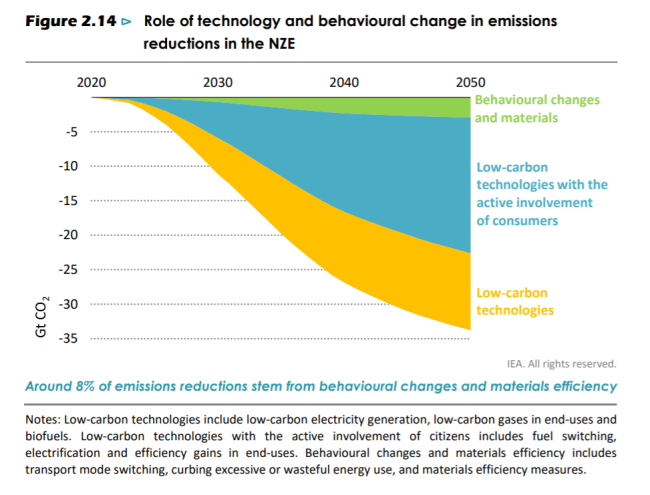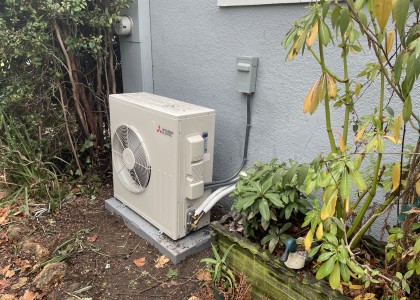The good news is that, according to a recent report by the International Energy Agency (IEA), the world can reach net-zero energy by 2050. The not-so-good news is that the world has a lot of heavy lifting to do. Notably, nearly two-thirds (roughly 63%) of the energy reduction needed to reach the net-zero goal will require people to change the way they do things – change their behavior and enthusiastically embrace more-efficient and healthier practices for the planet and themselves.
As the IEA puts it, “It is ultimately people who drive demand for energy‐related goods and services, and societal norms and personal choices will play a pivotal role in steering the energy system onto a sustainable path.”
This large-scale shift in behavior is not news to ACEEE, which has embedded behavior research and policy advocacy into its work since its inception more than 40 years ago. For others, though, it may come as something of a surprise, so let’s look at exactly what the IEA proposes and what we can do to get there.
What Is behavior change?
As part of behavior change, the IEA includes any energy savings that require consumers to change their demand for energy. Although nearly 40% of energy savings can be achieved without any shifts in consumer decisions or lifestyles, the rest will come from changes in how we do things, from adopting new technologies to changing how (and how much) we travel. The IEA identifies as critical three main categories of behavior:
- Reducing excessive or wasteful energy use: These behaviors include actions like adjusting indoor temperature settings and reducing driving speeds.
- Transportation mode switching: These behaviors relate to how we get around. Although two important steps are reducing single-occupancy vehicle use and phasing down cars in cities, the IEA calls out “reduced aviation demand” as the single most important change in transportation behavior. By keeping business and long-haul flights at 2019 levels and shifting many local flights to rail (probably about 17% of worldwide flights by 2050), aviation reductions can account for 80% of the travel-related emissions reductions by 2050. Notably, aviation travel demand is an under-studied area of transportation policy and behavior change and, going forward, should be the subject of increasing study and effort.
- Materials efficiency gains: This is a catch-all term to describe behaviors that reduce demand for materials. These mainly come from changes in building and automotive construction and design, as well as higher rates of recycling. Changes occur primarily through vehicle and buildings standards, which have the potential to regulate and eliminate the use of carbon-intensive building materials. However, the IEA notes that “societal preferences” drive changes in these types of policies – building standards, for example, are rarely mandated before builders voluntarily adopt them.
How can we change behavior on a large scale?
Achieving 63% energy reduction from behavior change might seem difficult or even impossible to people familiar with only a limited number of “behavior change programs,” such as home energy reports, which reduce consumption by an average of 1%-2% per household.
Indeed, the IEA describes multiple pathways for encouraging behavior change, with these sorts of voluntary “nudge” strategies (changing how energy decisions are framed and presented) accounting for only about 8% of energy savings. The report notes that “targeted government policies and infrastructure development” will account for about 75% of behavior change-related energy reductions. Some evidence suggests that public sentiment can change following implementation of environmental policies, as in Stockholm, where less than 40% of the population supported congestion pricing before implementation, but 70% supported it three years later.
The IEA describes three main strategies for changing behavior:
- Regulations and mandates: Examples include reducing speed limits, augmenting appliance and building standards, and establishing regulations that will help eventually shift passengers from short flights to trains.
- Market-based instruments: Examples include congestion pricing, taxes on fuel/distance/carbon, and mandatory energy labeling of products.
- Information and awareness: (“nudges”): Examples include personalized travel planning assistance, product labeling/public awareness campaigns, and comparison information and feedback.
Will it work in the USA?
Some may wonder if the IEA-recommended behavioral strategies that succeed in Europe could be expanded to the U.S. or the rest of the world, considering the different political, geographic, and social realities. For example, compared to the U.S., Europe has a better developed rail system, more walkable cities, and more appetite for the types of “disincentive” policies that the IEA applauds. The IEA acknowledges and somewhat accounts for regional variations, noting some regions will be faster at making these changes than others. Nevertheless, as it notes, much work needs to be done, particularly in wealthier countries.
Where do we go from here?
The report shows that, although technology development is important, people need to adopt the technology for it to have an impact. In essence, you can lead a horse to water, but you can’t make it drink. Without behavior change, including a demand for efficient technology and a willingness to adopt a reduced-carbon lifestyle, we cannot achieve the emissions reduction we need to reach net-zero energy by 2050.
Importantly, however, the IEA report shows that this desire and drive to change is already starting to take hold, and policies and programs to encourage these changes are within our reach. ACEEE is committed to take on this challenge and conduct research demonstrating a path toward a clean energy future using behavioral science, policy recommendations, and other tools at our disposal.





